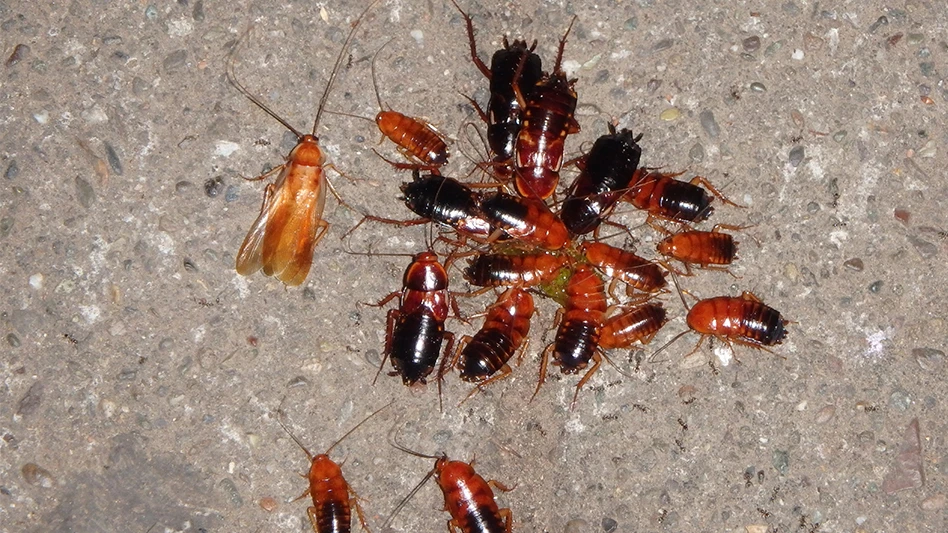
Photo courtesy of Andrew Sutherland
For pest management professionals in many parts of the country, particularly the desert Southwest, oriental cockroaches (Blatta orientalis) are being displaced by Turkestan cockroaches (Shelfordella lateralis).
At a symposium held at the 2022 National Conference on Urban Entomology in Salt Lake City, participants documented the prevalence of Turkestan cockroaches in warm regions of California, most or all of Arizona and New Mexico, parts of western Texas, Arkansas, parts of western Appalachia (western Tennessee and western Georgia), eastern Oregon, eastern Washington, adjacent portions of Idaho, and adjacent portions of British Columbia. It is likely that this species is also well established in Baja California and other regions of northern Mexico.
Andrew Sutherland, urban pest management researcher and educator at University of California, shared with PCT that although oriental and Turkestan cockroaches are closely related, there are important differences:
Females. Adult females of both species are dark brown to black, with reduced wings, sometimes called "wing buds." Female Turkestan cockroaches can be distinguished from female oriental cockroaches by the presence of cream-colored lateral bars on their wings and by narrower thoraxes. Look at the space between the "wing buds" — this space is narrower than the width of an individual wing bud on the Turkestan cockroach but wider than the width of an individual wing bud on the oriental cockroach.
Males. Adult male Turkestan cockroaches exhibit a golden, light-brown body color and have fully formed wings. In some cases, male Turkestan cockroaches have been observed to "glide" down from high perches or even to briefly fly. This is in contrast to male oriental cockroaches, which are medium to dark brown, have reduced wings, and are not capable of any kind of flight.
Nymphs. Nymphs of these two species can be difficult to distinguish, but Turkestan nymphs usually have red or reddish coloration on their head, thorax, and portions of their legs, while oriental cockroach nymphs are usually uniform medium to dark brown.
Because of these differences, Sutherland said, Turkestan cockroaches “are better adapted to hot dry climates and have displaced oriental cockroaches in many parts of the American Southwest (California, Arizona and Nevada, east to Arkansas and north to Washington).”
WHEN TO TREAT. Sutherland said it is important to note that Turkestan cockroaches only produce eggs during summer months and that this reproduction occurs over a period of time. “At this time of year, in most parts of North America you are mostly going to find nymphs and maybe a few adults that are in the process of dying.” In other words, adults do not usually overwinter. “So the time for management, if you have a population that is reproducing and really problematic, is before they deposit their eggs into the environment, which is going to be June/July. This is because the eggs within the oothecae will not be affected by insecticides, and nymphs hatching later in the season can easily re-establish the pest population.”
California experienced heavy rains this past winter and spring, and Sutherland said it will be interesting to see how this impacts Turkestan cockroach populations next year. “That may have created more food in the spring and summer, and may have led to increased egg production this summer. These roaches are omnivores, so they eat all kinds of things, like discarded food waste and even fruits that fall on the ground” as well as other insects and each other (they are cannibalistic).
Sutherland said both researchers and pest control operators have been able to successfully control Turkestan cockroaches using “structural exclusion tactics (sweeps and brushes on exterior doors, especially), gel baits within stations, gel and granular baits in known harborage areas, and targeted foams and sprays made directly to harborage areas.” He added that limited control has been reported with broadcasts of granular baits. Perimeter insecticide sprays may provide some control, but they will likely not control large populations, may drive insecticide resistance, and will not prevent cockroaches from entering structures.
Related articles:
Hubble, C., and Sutherland, A. 2019. Outdoor cockroach control: new species and new approaches. PestWorld, July / August 2019: https://www.pestworldmag-digital.com/npmas/0419_july_august_2019/MobilePagedArticle.action?articleId=1498660
Kim, T., and Rust, M.K. 2013. Life History and Biology of the Invasive Turkestan Cockroach (Dictyoptera: Blattidae), Journal of Economic Entomology 106(6), 2428–2432, https://doi.org/10.1603/EC13052
Sutherland, A.M., 2019. Effective bait-only control for outdoor cockroaches. UC IPM Green Bulletin 9:2, Summer 2019 Issue. http://ipm.ucanr.edu/PDF/PUBS/greenbulletin.2019.summer.pdf
The species is also well-covered in UC's Pest Notes 'Cockroaches' online publication: https://ipm.ucanr.edu/PMG/PESTNOTES/pn7467.html
Latest from Pest Control Technology
- Donny Oswalt Shares What Makes Termites a 'Tricky' Pest
- Study Finds Fecal Tests Can Reveal Active Termite Infestations
- Peachtree Pest Control Partners with Local Nonprofits to Fight Food Insecurity
- Allergy Technologies, PHA Expand ATAHC Complete Program to Protect 8,500 Homes
- Housecall Pro Hosts '25 Winter Summit Featuring Mike Rowe
- Advanced Education
- Spotted Lanternflies, BMSBs Most Problematic Invasive Pests, Poll Finds
- Ecolab Acquires Guardian Pest Solutions





